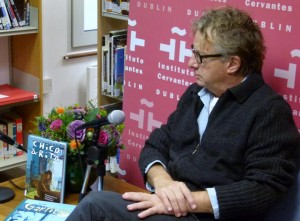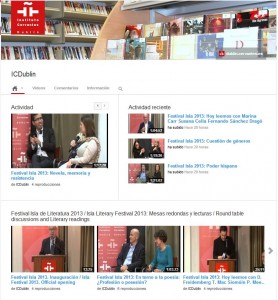Blog del Instituto Cervantes de Dublín
Torre Martello
Interview with Javier Mariscal
Javier Mariscal: “The brain is nothing cold, inert, it is completely sentimental.”

Interview with Javier Mariscal held on the 4th of November 2012, in Damaso Alonso Library, Instituto Cervantes Dublin with the purpose of participating in the ISLA Festival roundtable discussion “Words and Images: Cinema and Literature” by Mark O’Halloran and David Trueba.
Javier Mariscal ( Valencia, 1950) is primarily a creator of images who develops his work through many distinct media and disciplines. Along with his team Estudio Mariscal, founded in 1989, he has worked on numerous international projects (for H&M, The America’s Cup, Camper, among others) as well as a major exhibition of his work at the Design Museum in London “Mariscal Drawing Life”. He has produced two monographs: Mariscal Drawing Life and Sketches. In 2010, along with Fernando Trueba, he directed Chico and Rita, and published the graphic novel of the same name. In 2011 he also published the illustrated novel The Garriris. Chico & Rita was translated into English in 2011.
Vanesa Zafra: Javier, I am very interested in the creative process of graphic designers. How is it for you? Where do you begin the process?
Javier Mariscal: In all design processes, the first thing is to clearly understand the problem you have to solve. In any case, I see my studio as a store that we open in the morning and to which people come saying “I have a communication problem.” For example: “I want to make a record on which Pedrito Hernández will feature, a Cuban rumba singer who lives in New York. He loves all the music of Camarón de la Isla…” Well, from all the information you receive, you ask yourself how you order it. If we’re talking about a guy who is Cuban, sings rumba and the songs of Camarón de la Isla, well, this already has a colour.
Then there are the limits. In this case, you can not say “look, I’m going to make a record that is this big” [gestures widely with his hands]. Because then, in record stores, where they will put it? There are established formats. One can not re-invent anything. The disc will be round. You also have printing limitations and financial restrictions. Perhaps you can not do an inlay card that costs a lot of money.
What are the tools? Typography, colour, illustration, photography…and from here, what you do, as I say, is to process this information and put it in a way that produces a snapshot and if possible, one which touches the heart. Because how do we communicate? We communicate by feelings. The brain is nothing cold, inert, it is completely sentimental.
Vanesa Zafra: Is this the philosophy of your studio? Emotion, humour, fun? How it is structured within a team of many people?
Javier Mariscal: Well, I have no idea. These are questions that I don’t ask myself. This is something more a posteriori, which is itself a very strange word. I do not know. It is a way of establishing things. I will, all my life since I was small, take a stone and say “Look! An airplane!” And then my children, or others will say, “Oh yeah, look! Careful, careful, because I have another one. You are going to crash!” It’s an animalistic way to understand and communicate with each other that we learn when we are very little. I have seen English and Catalan children play without speaking any language, but they understand each other immediately. With a “shun chin chin chu pan bread pa chi cha”. It is the first really potent language that we learn as children. But many kids around the ages of 12 or 15 begin to say: “No no no, this is not an airplane, this is a stone. end of story”.
As a designer, I, and I think the vast majority of other designers, have never stopped working with that system of thought which involves play. This is where one suddenly sees humour. But it is a case of play and more play. Nowadays I have stopped getting insulted, but for a long time people have insulted me. For playing.
Vanesa Zafra: – We are all born creative but we lose this quality when we learn things to become adults. Can we reverse the process?
Javier Mariscal: Being creative is like breathing. Everyone on earth is creative and we are all creative from birth. It is something we have because if not, one would die. It is immediately apparent. You take some shoes like yours that have long laces, so you are creative and you develop a system for removing them and putting them in the easiest way. And this is creativity. I do not understand why some say “you people are so creative”. Well, what about you? Do you think you’re not creative?
Vanesa Zafra: Do you listen to music while you work?
Javier Mariscal: Sometimes, sometimes not. There have been seasons was like a vice. It was impossible to work without music.
Vanesa Zafra: Recommend an album to me.
Javier Mariscal: I would recommend Lágrimas Negras (Black Tears), one of the best albums that has been produced in the last twenty centuries. Because at the time of the Romans there were some very good albums , the problem is they have been lost.
Vanesa Zafra: Something that surprised you, something creative, a work or a movement, perhaps a recent movie…
Javier Mariscal: A movie … Up, for example, was wonderful. Especially the opening section. But of course, it is something obvious. Everyone who has seen it says ” Wow, isn’t the beginning of Up so beautiful, so elegant?” Who knows. Recently I saw a short, a little thing that a friend of mine, Miguel Gallardo, made. Wonderful. There are thousands and thousands of things. Thank God one continually sees these works, other people’s stuff, all this good work, and one remains fascinated. This is what you need to feed your imagination. If not, what else would inspire you?
Vanesa Zafra: And with the internet nowadays, you could be looking through it every day…
Javier Mariscal: Well, I don’t waste much time looking at Internet every day you know? It bores me terribly.
Vanesa Zafra: And what about social networking?
Javier Mariscal: For a while, I was on social networks, it happened suddenly. But now, I don’t know why I haven’t been. I’m not on Facebook. And look, I was posting a picture every day.
Vanesa Zafra: Yes but be a slave to that…
Javier Mariscal: Slave ? No, no, one doesn’t become a slave. It’s done for fun, or not at all.
Recommended Links
- [Video] Interview with Javier Mariscal at the Instituto Cervantes in Dublin by Vanesa Zafra.



